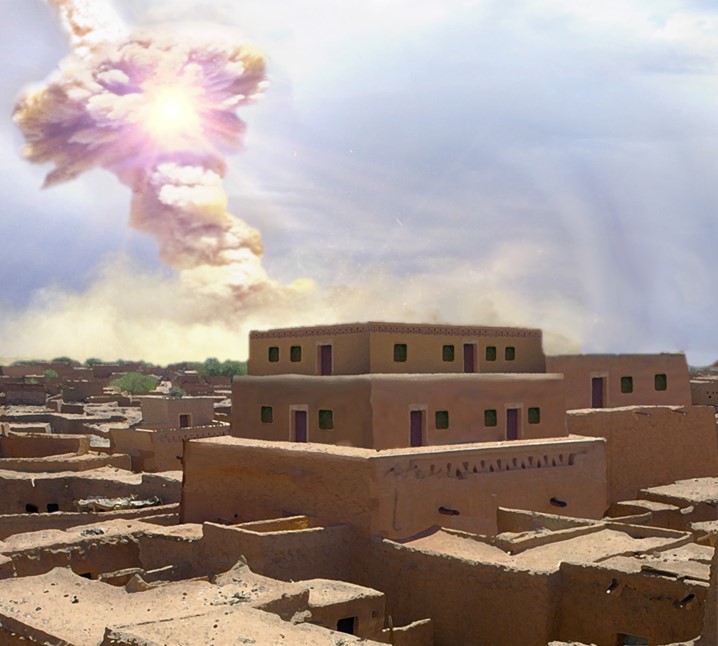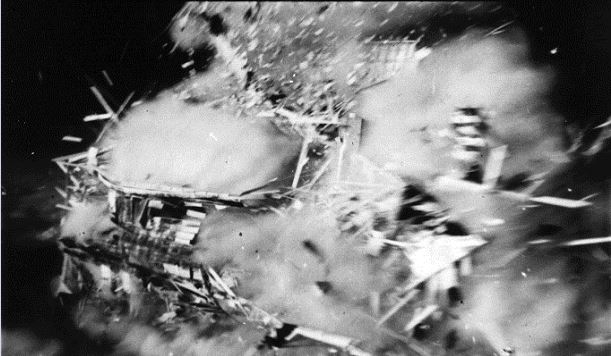I’ve mentioned the excavations at Tall el-Hammam before, for example here and here, in connection with the increasingly plausible theory that this site is the biblical Sodom, with a highly unusual destruction layer from the 17th century BCE. Now, in case you’ve not noticed, a major article in Nature by a specialist group explores the destruction evidence in detail, and concludes that the most likely explanation is a Tunguska-type airburst around the year 1650 BCE.
The full paper is available here, and it makes very interesting reading. Inevitably it makes some reference to the Genesis account, not least because the original exacavation was organised by one of those despised biblical archaeologists “with a Bible in one hand and a trowel in the other,” whose laughable technique appears to have paid off not only in corroborating the biblical story, but in finding only the second human settlement, one of major importance in antiquity, known to have been destroyed by an astronomical event.

The first blog I cite above, from 2017, refers to the grudging response from minimalist archaeologists that, if confirmed, the story of the site might make the Genesis account an aetiological tale of a real event, rather than a pure fiction as they had always assumed. The second, from 2019, points to the typical materialist line that finding evidence for an actual event shows that the biblical account is misinterpreting a purely “natural” event as an act of God- leading me to question quite what is meant by “natural.”
The Nature article is admirably less ideological, pointing out the authors’ incompetence to stray beyond their field, and merely suggesting that the close correlation between the Genesis account and the scientific findings suggests an eyewitness account that was handed down orally until “finally” being incorporated into the Genesis account.
Even that is rather too confident about the nature of the process from historical event to Torah. There is no intrinsic reason why Genesis might not have incorporated a written eyewitness account. And more to the point, given the lack of other ancient accounts of the event, the best reason to include the story in the “biography” of Abraham, which is the foundation story of Israel, was because Abraham was the recording eye-witness (or the historian preserving a report closer to the event, such as that of Lot, the claimed founder of the Ammonites and the Moabites, who were important in Israel’s history).
There are two broad reasons for the Torah to include the destruction of Sodom and Gomorrah. The first, as I have hinted, is that it is important for Israel’s understanding of the relationship between Abraham and Lot, and hence between themselves and Lot’s descendants.
The second is to demonstrate that Yahweh is, indeed, the active judge of the whole earth, and to show how Abraham, as his chosen vessel, becomes responsibly involved in God’s planning (Gen 18:17-19). Abraham had already had dealings with the king of Sodom, as a military ally, but his sense of sound moral judgement has been shown in 14:22-23 by his refusal, under oath to Yahweh, to allow that king to make him rich. In all this Abraham is shown to be a successor to Adam, in the cosmic plan God has to bring mankind into the spiritual rule of the world – see my book The Generations of Heaven and Earth, from all good bookshops…
In other words, Sodom is in the Bible because its destruction is woven into the fabric of salvation history, which is the unfolding of God’s final purposes for the world through actual events in the world. The destruction of Sodom and Gomorrah becomes a paradigm of divine judgement in the rest of the Bible, from Ezekiel to the teaching of Jesus himself. Peter (2 Peter 2:6) uses the destruction of Sodom and Gomorrah, and the sparing of Lot, to illustrate the end times judgement on the unrighteous, and the preservation of the godly “from temptation.” Jude seems to use it of the destruction of false teachers in the church at the coming of Christ. And John names the “great city” where the two witnesses are slain as, mystically speaking, “Sodom and Egypt, where also their Lord was crucified” (Rev 11:8). In this he may, assuming the earlier date for composition, have been prophetically anticipating the destruction of Jerusalem in 69-70AD, but more broadly I’m sure he speaks of the world system antithetical to the saints and to God, whose destruction is so graphically decribed in Rev 17, where Babylon is named, and both Rome and Jerusalem probably referenced.
We are nowadays tempted either to imagine that God’s judgement is purely hypothetical (“God loves us as we are, unconditionally – he would never cause people harm), or at least that it is safely reserved for a future age, and of a purely spiritual nature, whatever that means.
But Jerusalem and Babylon were both real cities, and their destruction at various times was equally historic and and terrible. The later sack of Rome, too, was not a drill. So for science to confirm not only the existence, but the cosmic destruction, of the Cities of the Plain gives us yet another example of God’s government of the real world, through physical acts of judgement, within history.
As an event, of course, science can only regard something like the destruction of Tall el-Hammam in its “natural” aspect. But the Bible, as I have said, was not written simply as a gloss on natural events, but as a revealed explanation of such events. If, by the Holy Spirit, we accept the teaching of the Bible, then we begin to understand history from God’s point of view. At the same time, the closer that the Bible’s accounts are shown to be to historical events, the more its plausibility as an authoritative explanation is increased. If Sodom’s destruction looks like an eyewitness description, down to the salt deposition on its human victims, then Abraham looks like the likely eyewitness (his own historical and cultural setting having long been shown to be compatible with the same time and place, and no other). And if the eyewitness reports the airburst accurately, why should we not believe him about the other events of his life, so clearly involving encounter with the divine?
Now, about those biblical prophecies about end-time satanic deception, apostasy and chaos, and the current situation in the world…


A welcome return to Genesis themes, and I look forward to more, Jon!
Looks like it’s down to the archaeologists to dig up more Genesis gold!
Jon,
I wanted to be a Biblical archaeologist when I was a young girl. Real life pretty much beat it out of me but I never lost interest in these things.
It would be fabulous to see more articles like this.
Elizabeth
I too wanted to be an archaeologist (not specifically biblical) until my Aunt Dorothy put me off by saying they spend all day down a hole.
I did a week on a dig at Ein Gedi, and she was actually right!
With respect to “God loves us as we are, unconditionally – he would never cause people harm”, you might like this series: https://threadreaderapp.com/thread/1442392296515784708.html
Oh yes – very perceptive stuff!